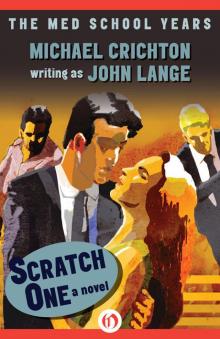- Home
- Michael Crichton
Five Patients Page 4
Five Patients Read online
Page 4
Page 4
Second, by definition the hospital has not done much in the area of preventive medicine. No hospital ever has. Since the aesculapia, hospitals have defined themselves as passive institutions, taking whoever comes to them but seeking no one out. There are some peculiar sidelights to this. For example, a high percentage of patients in the acute psychiatric service give a family history of severe psychiatric disturbance. In the case of the young girl who had tried to kill her child, her father was an alcoholic; her mother and younger brother had committed suicide; her twenty-year-old husband, a shoe salesman, had recently been admitted to a state hospital for an acute psychotic break.
It is possible to think of psychiatric illness as almost infectious, in the sense that these disorders are so frequently self-perpetuating. One is tempted to reflect that true infectious disease is best treated in the community, using direct preventive and therapeutic measures; indeed, the conquest of infectious disease-one of the triumphs of medicine in this century-is something for which the hospital, as an institution, can take no credit at all.
In the same way, it is in the hospitals approach to mental illness that its limitations as a curative institution, treating already established disease, are today most striking. If major inroads are to be made, they will not come from the hospital system as it is presently structured, any more than the old specialized hospitals for tuberculosis, leprosy, and smallpox had any real impact on the decline of those diseases.
Some of the ways the hospital is restructuring itself to meet these limitations will be discussed later. But the hospital is also revising its internal workings, and that is the subject of the next chapter.
Chapter 2
John OConnor. The Cost of Cure
Until his admission, john oconnor, a fifty-year-old railroad dispatcher from Charles-town, was in perfect health. He had never been sick a day in his life.
On the morning of his admission, he awoke early, complaining of vague abdominal pain. He vomited once, bringing up clear material, and had some diarrhea. He went to see his family doctor, who said that he had no fever and his white cell count was normal. He told Mr. OConnor that it was probably gastroenteritis, and advised him to rest and take paregoric to settle his stomach.
In the afternoon, Mr. OConnor began to feel warm. He then had two shaking chills. His wife suggested he call his doctor once again, but when Mr. OConnor went to the phone, he collapsed. At 5 p. m. his wife brought him to the MGH emergency ward, where he was noted to have a temperature of 108 F. and a white count of 37,000 (normal count: 5,000-10,000).
The patient was wildly delirious; it required ten people to hold him down as he thrashed about. He spoke only nonsense words and groans, and did not respond to his name. While in the emergency ward he had massive diarrhea consisting of several quarts of watery fluid.
The patient was seen by the medical resident, John Minna, who instituted immediate therapy consisting of aspirin, alcohol rubs, fans and a refrigerating blanket to bring down his fever, which rapidly fell to 100 . He was in shock with an initial blood pressure of 70/30 and a central venous pressure of zero. Over the next three hours he received three quarts of plasma and two quarts of salt water intravenously, to replace fluids lost from sweating and diarrhea. He was also severely aci-dotic, so he was given twelve ampoules of intravenous sodium bicarbonate as well as potassium chloride to correct an electrolyte imbalance.
The patient could not give a history. His wife, upon questioning, denied any history of malaria, distant travel, food exposure, infectious disease, headache, neck stiffness, cough, sputum, sore throat, swollen glands, arthritis, muscle aches, seizures, skin infection, drug ingestion, or past suicide attempts.
His past history, according to the wife, was unremarkable. He had never been ill or hospitalized. His mother died at age fifty-five of leukemia; his father at age fifty-nine, of pneumonia. The patient had no known allergies, and did not smoke or drink.
Physical examination was normal except for a slightly distended abdomen and a questionably enlarged liver, which could be felt below the rib cage. Neurological examination was normal except for the patients stuporous, unresponsive mental state.
The patient was cultured "stem to stern," meaning that samples of blood, urine, stool, sputum, and spinal fluid were sent for bacteriologic analysis. He was also given heavy doses of antibiotics, including a gram of chloramphenicol, a gram of oxacillin, two million units of penicillin; later in the evening, kanamycin and colistin were added to the list.
X rays of the chest and abdomen were normal. Electrocardiogram was normal. Hematocrit was normal. The white count was elevated at 37,000 with a preponderance of polymorphonuclear leukocytes, the cells which increase in bacterial infections. Examination of the urine showed a few white cells. Platelet count and prothrombin time were normal. Measurements of blood sugar, serum amylase, serum acetone, bilirubin, and blood urea nitrogen were normal. Lumbar puncture was normal.
An intravenous pyelogram (an X ray of the kidneys to check their function while they excrete an opaque dye) showed that the left kidney was normal, but the right kidney responded sluggishly. The excretory tubing on the right side seemed dilated. A diagnosis of partial obstruction of the right kidney system was suggested.
Because the abdomen was distended, six abdominal taps were performed in different areas by the surgical residents, Drs. Robert Corry and Jay Kaufman, in an attempt to obtain fluid from the abdominal cavity. None was obtained.
Dr. Minnas diagnosis was septicemia, or generalized infection of the bloodstream, from an unknown source. As possibilities he listed the urinary tract, the gastrointestinal tract, the gall bladder, or the lining of the heart. He felt that there was no good evidence for a central nervous system cause for the fever, and no good history of drug inges-tion or thyroid problems to account for the fever.
This was essentially the conclusion of the neurological consultants who saw the patient later in the evening. They felt that Mr. OConnor had suffered a primary infectious process with sudden outpouring of bacteria into the blood, and consequent fever and prostration. They felt the infection was somewhere in the urinary or gastrointestinal system, or perhaps even in a small area of the lungs. In their opinion, meningitis, encephalitis, subarachnoid hemorrhage, or other central nervous problems were unlikely.
A formal surgical consult, also later in the evening, reported that in the absence of muscle spasm or guarding of the abdomen, and in the presence of six negative taps, an acute abdominal crisis was unlikely.
Genito-urinary consultants examined the patient that same evening and reviewed his kidney X rays. They felt that there was a probable partial obstruction of the right kidney, but they could not determine whether this was a recent or a slowly developing change. They found no evidence of infection of the prostate gland to explain the fever. Mr. OConnor was placed on the Danger List and transferred to the intensive-care unit of the Bulfinch Building. At the end of his first twelve hours in the hospital, his fever had been reduced, but was still unexplained.
Before continuing with Mr. OConnors hospital course, it is worth pausing a moment to consider the patients initial symptoms, and initial therapy.
Mr. OConnor was presented with high fever and shock. Classically, the fever of unknown origin is a pediatric problem, and classically it is a problem for the same reasons it was a problem with Mr. OConnor-the patient cannot tell you how he feels or what hurts. However, a high fever in a child is less worrisome than it is in an adult, for children have a much greater tolerance for fever. In adults, prolonged high fever is more likely to result in permanent brain damage and death.
The most common cause of fever for anyone, child or adult, is infection; the most common cause of fever of unknown origin is also infection. There are some unusual causes occasionally seen, such as malignancies, bleeding in the brain, drug ingestion, and outpouring of thyroid hormone, but, for the most part, unexplained fevers are produced by unidentified infection
s.
It is now known that one can harbor an infection in a secluded part of the body, and the body will make very little response to it; however, if the infection spreads into the bloodstream, there may be a "shower" of bacteria, and a subsequent rise in temperature. The shower is usually brief, lasting minutes or hours, and often ends before the temperature rises. This makes diagnosis difficult-if one wants to catch bacteria in the blood, one must draw a sample before the temperature spike, and not during it or after it.
It was thought that Mr. OConnor was suffering from precisely this sort of situation: a sequestered infection producing episodic bursts of bacteria into the blood, with episodic fever. However, his fever was threateningly high. And thus a classic conflict in therapy as old as Hippocrates.
"For extreme diseases, extreme remedies," Hippocrates wrote. But he also said: "For grave diseases, the most exact therapy is best. " But, obviously, an exact therapy depends upon a precise diagnosis, and here lies the conflict.
What is a diagnosis? The question is not as simple-minded as it first appears, for the notion of what constitutes an acceptable diagnosis has radically changed through the years.
A diagnosis is drawn up on the basis of two kinds of knowledge: the physicians concept of disease processes, and his available therapies. Ideally, a diagnosis contains some sense of etiology- the cause of the disease-but for most of medical history etiology was either ignored or wrongly ascribed (as in "fever from excess of black bile").
In a modern sense, precise diagnosis is required because precise therapies are available. Yet the need for precise diagnosis is older; in Hippocratic time, this need was based on a prognostic, not a therapeutic, concern. Physicians were unskilled at curing disease and therefore served mostly to predict the course of an illness which they could not influence. Robert Platt notes that "until quite recently. . . it did not matter whether your diagnosis was right or wrong. . . Prognosis mattered rather more, especially to the doctors reputation. "
Hippocrates was deeply concerned with the prestige of the physician as related to prognostic acumen; much Hippocratic writing shows this preoccupation with prognosis: "Sleep following upon delirium is a good sign. " "Those who swoon frequently without apparent cause are liable to die suddenly. " "Labored sleep in any disease is a bad sign. " "Spasm supervening upon a wound is dangerous. " "Hardening of the liver in jaundice is bad. " "If a convalescent eats heartily, yet does not take on flesh, it is a bad sign. "
These observations are still valid today. But we demand something further from diagnosis, as the range of therapies has increased. If a person swoons, for example, it is important to know whether he has aortic stenosis-and is likely to die suddenly-or whether he is hysterical, or diabetic, or has some other reason for fainting. In short, we want more precise diagnoses because we have more precise therapies.
Throughout medical history, physicians have felt that they had precise, specific remedies, but few of these are still acceptable. As medical writer Berton Roueche notes, only three eighteenth-century drugs are still acceptable today: quinine for malaria, colchicine for gout, and foxglove (digitalis) for heart failure. All the other "specifics," as well as what Holmes termed the "peremptory drastics," have disappeared.
Even as recently as 1910, L. J. Henderson commented that "if the average patient visited the average physician, he would have a fifty-fifty chance of benefiting from the encounter. " Much has happened since then-in fact, nearly every diagnostic test and therapeutic procedure performed on Mr. OConnor during those first twelve hours has been developed since 1910. For clinically, diagnosis and therapy go hand in hand; increasing sophistication in either one demands increased sophistication in the other.
The proliferation of tests and techniques in this century is staggering. Consider the following list of tests performed on Mr. OConnor, and the dates those tests were first described in clinically practical terms:
X ray: chest and abdomen (1905-15)
White cell count (about 1895)
Serum acetone (1928)
Amylase (1948)
Calcium (1931)
Phosphorus (1925)
SCOT (1955)
LDH (1956)
CPK (1961)
John OConnor 45
Aldolase (1949)
Lipase (1934)
CSF protein (1931)
CSF sugar (1932)
Blood sugar (1932)
Bilirubin (1937)
Serum albumin/globulin (1923-38)
Electrolytes (1941-6)
Electrocardiogram (about 1915)
Prothrombin time (1940)
Blood pH (1924-57)
Blood gases (1957)
Protein-bound iodine (1948)
Alkaline phosphatase (1933)
Watson-Schwartz (1941)
Creatinine (1933)
Uric acid (1933)
If one were to graph these tests, and others commonly used, against the total time course of medical history, one would see a flat line for more than two thousand years, followed by a slight rise beginning about 1850, and then an ever-sharper rise to the present time.
That is the meaning of technological innovation. It has struck medicine like a thunderbolt: far more advances have occurred in medicine in the last hundred years than occurred in the previous two thousand. There is no mystery why this should be so. Most research scientists in history are alive today; therefore most of the discoveries in history are being made today. But the consequences of this vast outpouring of information and technology have yet to be grasped. Major questions are raised in such widely diverse subjects as medical education and euthanasia.
What makes the case of Mr. OConnor so interesting is the way it illustrates the vast web of technological advances that make diagnostic techniques and treatment today so radically different from what they were only thirty years ago.
Presumably, Mr. OConnor had an infection. The treatment of infectious disease is considered one of the triumphs of modern medicine, crowned by the introduction of antibiotics. But as the bacteriologist Rene Dubos has pointed out. "The decrease in mortality caused by infection began nearly a century ago and has continued ever since at a fairly constant rate irrespective of the use of any specific therapy. " He says, further, that "these triumphs of modern chemotherapy have transformed the practice of medicine and are changing the very pattern of disease in the western world, but there is no reason to believe that they spell the conquest of microbial diseases. "

 Dragon Teeth
Dragon Teeth Jurassic Park
Jurassic Park Micro
Micro The Great Train Robbery
The Great Train Robbery The Andromeda Strain
The Andromeda Strain The Lost World
The Lost World Congo
Congo Travels
Travels Timeline
Timeline Sphere
Sphere Westworld
Westworld Prey
Prey State Of Fear
State Of Fear Next
Next Disclosure
Disclosure Pirate Latitudes
Pirate Latitudes The Terminal Man
The Terminal Man Five Patients
Five Patients Rising Sun
Rising Sun Binary
Binary The Andromeda Evolution
The Andromeda Evolution Airframe
Airframe Easy Go
Easy Go Drug of Choice
Drug of Choice Odds On: A Novel
Odds On: A Novel Scratch One
Scratch One Dealing or The Berkeley-to-Boston Forty-Brick Lost-Bag Blues
Dealing or The Berkeley-to-Boston Forty-Brick Lost-Bag Blues Venom Business
Venom Business Grave Descend
Grave Descend Gold - Pirate Latitudes
Gold - Pirate Latitudes Binary: A Novel
Binary: A Novel Zero Cool
Zero Cool Delos 1 - Westworld
Delos 1 - Westworld